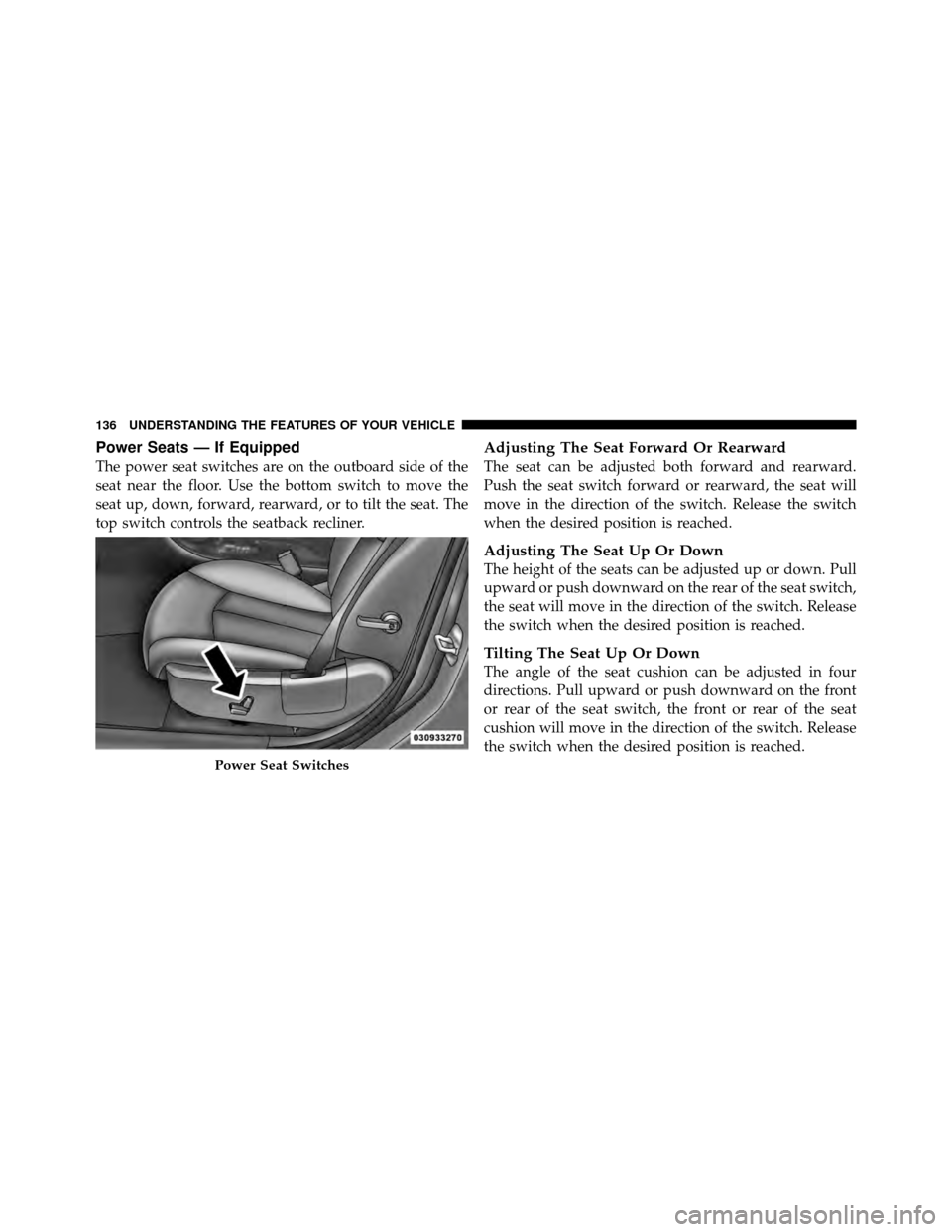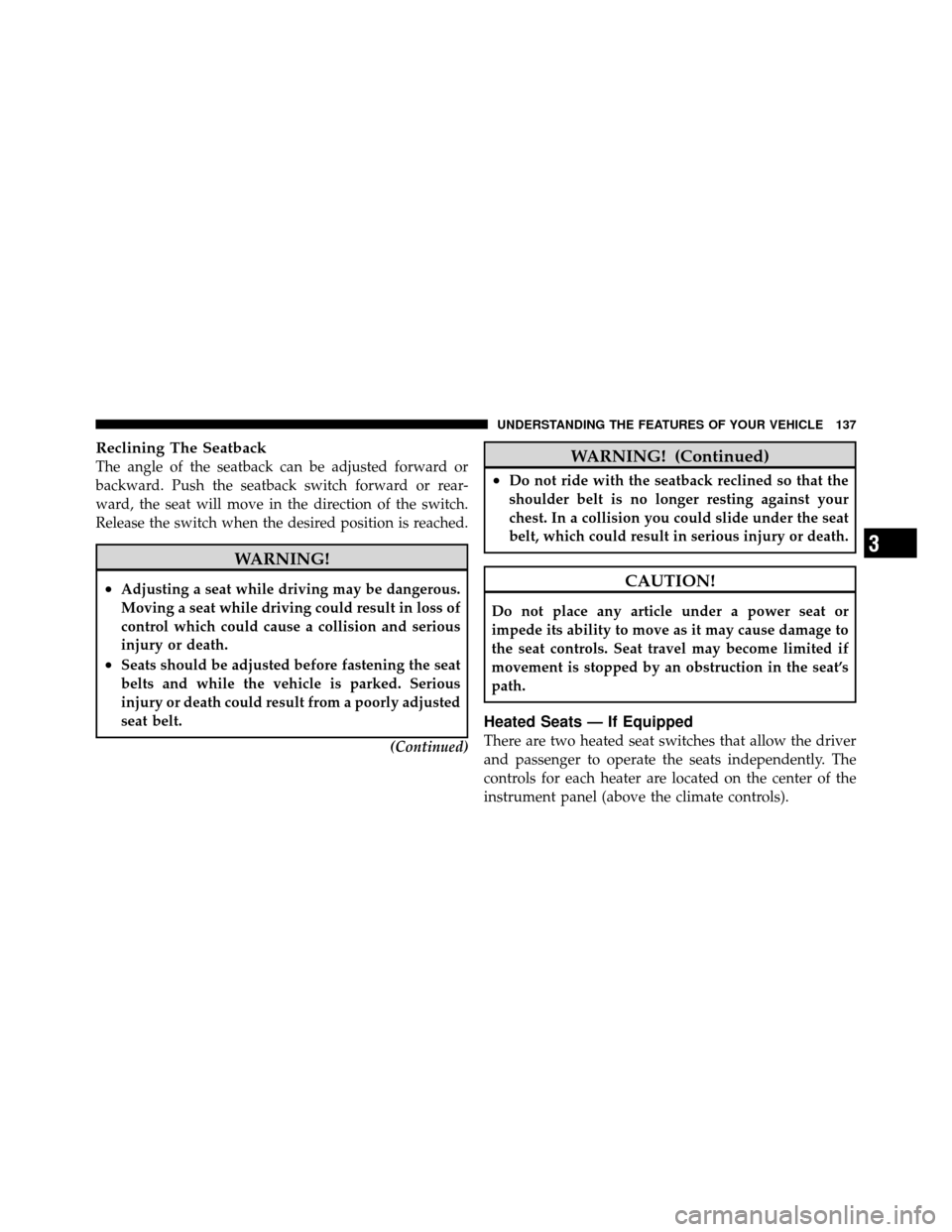Page 86 of 508

Children Too Large For Booster Seats
Children who are large enough to wear the shoulder belt
comfortably, and whose legs are long enough to bend
over the front of the seat when their back is against the
seatback, should use the lap/shoulder belt in a rear seat.
Make sure that:
•The child is upright in the seat.
•The lap portion should be low on the hips and as snug
as possible.
•Check belt fit periodically. A child’s squirming or
slouching can move the belt out of position.
•If the shoulder belt contacts the face or neck, move the
child closer to the center of the vehicle. Never allow a
child to put the shoulder belt under an arm or behind
their back.
Transporting Pets
Air Bags deploying in the front seat could harm your pet.
An unrestrained pet will be thrown about and possibly
injured, or injure a passenger during panic braking or in
a collision.
Pets should be restrained in the rear seat in pet harnesses
or pet carriers that are secured by seat belts.
ENGINE BREAK-IN RECOMMENDATIONS
A long break-in period is not required for the engine and
drivetrain (transmission and axle) in your vehicle.
Drive moderately during the first 300 miles (500 km).
After the initial 60 miles (100 km), speeds up to 50 or
55 mph (80 or 90 km/h) are desirable.
While cruising, brief full-throttle acceleration within the
limits of local traffic laws contributes to a good break-in.
Wide-open throttle acceleration in low gear can be detri-
mental and should be avoided.
84 THINGS TO KNOW BEFORE STARTING YOUR VEHICLE
Page 87 of 508

The engine oil installed in the engine at the factory is a
high-quality energy conserving type lubricant. Oil
changes should be consistent with anticipated climate
conditions under which vehicle operations will occur. For
the recommended viscosity and quality grades, refer to
“Maintenance Procedures” in “Maintaining Your Ve-
hicle”.
CAUTION!
Never use Non-Detergent Oil or Straight Mineral Oil
in the engine or damage may result.
NOTE: A new engine may consume some oil during its
first few thousand miles (kilometers) of operation. This
should be considered a normal part of the break-in and
not interpreted as an indication of difficulty.
SAFETY TIPS
Transporting Passengers
NEVER TRANSPORT PASSENGERS IN THE CARGO
AREA.
WARNING!
•Do not leave children or animals inside parked
vehicles in hot weather. Interior heat build-up may
cause serious injury or death.
•It is extremely dangerous to ride in a cargo area,
inside or outside of a vehicle. In a collision, people
riding in these areas are more likely to be seri-
ously injured or killed.
•Do not allow people to ride in any area of your
vehicle that is not equipped with seats and seat
belts.
•Be sure everyone in your vehicle is in a seat and
using a seat belt properly.
2
THINGS TO KNOW BEFORE STARTING YOUR VEHICLE 85
Page 94 of 508

�Voice Command — If Equipped ........... 130
▫ Voice Command System Operation ........ 130
▫ Commands ........................ 131
▫ Voice Training ...................... 135
� Seats .............................. 135
▫ Power Seats — If Equipped ............. 136
▫ Heated Seats — If Equipped ............ 137
▫ Manual Front Seat Adjustment ........... 139
▫ Driver Seat Manual Height Adjuster — If
Equipped .......................... 140
▫ Reclining Seats ...................... 140
▫ Lumbar Support — If Equipped .......... 141
▫ Head Restraints ..................... 141 ▫
Fold-Flat Passenger Seatback ............ 145
▫ Folding Rear Seat .................... 146
▫ Folding Rear Seat Center Armrest ........ 147
� To Open And Close The Hood ............ 148
� Lights ............................. 149
▫ Multifunction Lever .................. 149
▫ Headlights And Parking Lights .......... 150
▫ Automatic Headlights — If Equipped ...... 151
▫ Headlight Time Delay ................. 151
▫ Turn Signals ........................ 152
▫ Lane Change Assist ................... 152
▫ High/Low Beam Switch ............... 152
▫ Flash-To-Pass ....................... 153
92 UNDERSTANDING THE FEATURES OF YOUR VEHICLE
Page 137 of 508

Voice Training
For users experiencing difficulty with the system recog-
nizing their voice commands or numbers the Uconnect™
Voice “Voice Training” feature may be used.
1. Press the Voice Command
button, say “System
Setup” and once you are in that menu then say “Voice
Training.” This will train your own voice to the system
and will improve recognition.
2. Repeat the words and phrases when prompted by
Uconnect™ Voice. For best results, the “Voice Training”
session should be completed when the vehicle is parked,
engine running, all windows closed, and the blower fan
switched off. This procedure may be repeated with a new
user. The system will adapt to the last trained voice only.
SEATS
Seats are a part of the Occupant Restraint System of the
vehicle.
WARNING!
•It is dangerous to ride in a cargo area, inside or
outside of a vehicle. In a collision, people riding in
these areas are more likely to be seriously injured
or killed.
•Do not allow people to ride in any area of your
vehicle that is not equipped with seats and seat
belts. In a collision, people riding in these areas
are more likely to be seriously injured or killed.
•Be sure everyone in your vehicle is in a seat and
using a seat belt properly.
3
UNDERSTANDING THE FEATURES OF YOUR VEHICLE 135
Page 138 of 508

Power Seats — If Equipped
The power seat switches are on the outboard side of the
seat near the floor. Use the bottom switch to move the
seat up, down, forward, rearward, or to tilt the seat. The
top switch controls the seatback recliner.
Adjusting The Seat Forward Or Rearward
The seat can be adjusted both forward and rearward.
Push the seat switch forward or rearward, the seat will
move in the direction of the switch. Release the switch
when the desired position is reached.
Adjusting The Seat Up Or Down
The height of the seats can be adjusted up or down. Pull
upward or push downward on the rear of the seat switch,
the seat will move in the direction of the switch. Release
the switch when the desired position is reached.
Tilting The Seat Up Or Down
The angle of the seat cushion can be adjusted in four
directions. Pull upward or push downward on the front
or rear of the seat switch, the front or rear of the seat
cushion will move in the direction of the switch. Release
the switch when the desired position is reached.
Power Seat Switches
136 UNDERSTANDING THE FEATURES OF YOUR VEHICLE
Page 139 of 508

Reclining The Seatback
The angle of the seatback can be adjusted forward or
backward. Push the seatback switch forward or rear-
ward, the seat will move in the direction of the switch.
Release the switch when the desired position is reached.
WARNING!
•Adjusting a seat while driving may be dangerous.
Moving a seat while driving could result in loss of
control which could cause a collision and serious
injury or death.
•Seats should be adjusted before fastening the seat
belts and while the vehicle is parked. Serious
injury or death could result from a poorly adjusted
seat belt.(Continued)
WARNING! (Continued)
•Do not ride with the seatback reclined so that the
shoulder belt is no longer resting against your
chest. In a collision you could slide under the seat
belt, which could result in serious injury or death.
CAUTION!
Do not place any article under a power seat or
impede its ability to move as it may cause damage to
the seat controls. Seat travel may become limited if
movement is stopped by an obstruction in the seat’s
path.
Heated Seats — If Equipped
There are two heated seat switches that allow the driver
and passenger to operate the seats independently. The
controls for each heater are located on the center of the
instrument panel (above the climate controls).
3
UNDERSTANDING THE FEATURES OF YOUR VEHICLE 137
Page 142 of 508
Driver Seat Manual Height Adjuster — If
Equipped
A lever style height adjustment feature enhances comfort
for petite as well as tall drivers. A lever with a ratcheting
mechanism, located on the outboard side of the seat,
raises and lowers it. Total travel is 2.2 in (56 mm).
Reclining Seats
The recliner control is located on the side of the seat. To
recline, lean forward slightly before lifting the lever, then
lean back to the desired position and release the lever.
Lean forward and lift the lever to return the seatback to
its normal position.
Manual Seat Height Adjustment LeverSeatback Adjustment
140 UNDERSTANDING THE FEATURES OF YOUR VEHICLE
Page 144 of 508

WARNING!
The head restraints for all occupants must be prop-
erly adjusted prior to operating the vehicle or occu-
pying a seat. Head restraints should never be ad-
justed while the vehicle is in motion. Driving a
vehicle with the head restraints improperly adjusted
or removed could cause serious injury or death in the
event of a collision.
Active Head Restraints — Front Seats
Active Head Restraints are passive, deployable compo-
nents, and vehicles with this equipment cannot be readily
identified by any markings, only through visual inspec-
tion of the head restraint. The head restraint will be split
in two halves, with the front half being soft foam and
trim, the back half being decorative plastic.When AHRs deploy during a rear impact, the front half
of the head restraint extends forward to minimize the gap
between the back of the occupant’s head and the AHR.
This system is designed to help prevent or reduce the
extent of injuries to the driver and front passenger in
certain types of rear impacts. Refer to “Occupant Re-
straints” in “Things To Know Before Starting Your Ve-
hicle” for further information.
To raise the head restraint, pull upward on the head
restraint. To lower the head restraint, press the push
button, located at the base of the head restraint, and push
downward on the head restraint.
142 UNDERSTANDING THE FEATURES OF YOUR VEHICLE